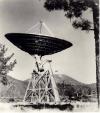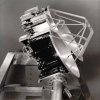![[Doc Ewen looks into the horn antenna, 1950]](ewen_horn1s.jpg)
|
| Image courtesy of Doc Ewen |
Introduction
Harvard Cyclotron: 1948-1951
Detection of HI Line: 1951
Harvard 24ft and 60ft and NRAO founding: 1952-1956
1950s and 1960s: Two Roads that Crossed
Microwave & Millimeter Wave Applications in the 1970s and 1980s
Mm Wave Radiometry in the 1990s
May 2001 visit to NRAO Green Bank
Bibliography
Permissions
![[Doc Ewen and horn antenna, 2001]](ewen_horn2s.jpg) |
| Image courtesy of Doc Ewen |
Doc Ewen: The Horn, HI, and Other Events in US Radio Astronomy
by Doc Ewen, © 2003
Modified on Friday, 28-Jan-2005 11:42:47 EST by Ellen BoutonIn the 1950s and 1960s, radio astronomy and the telescopes being built were the beneficiaries of new Defense Department technology developed for ballistic missile early warning systems and for the space age. When Sputnik passed overhead, perimeter surveillance, along with eavesdropping over the horizon, became obsolete. Defense activities moved from the land and sea perimeters to space. Slide presentation: Two Roads that Crossed in the Wood - Growth of US Radio Astronomy in the 1950s and 1960s
(Click on the thumbnails for larger photos and fuller explanations.)

Slide 1: Sputnik passes overhead: satellite signal, 7 October 1957. The need for a global communications capability to support Department of Defense space activities in near earth orbit led to the installation of ground stations around the world to provide continuous coverage. The steerable antennas were 85 to 210 feet in diameter. Radio astronomy said thank you by purchasing several of the 85 foot antennas. Harvard traded in its 60 foot reflector for an 85 foot reflector. NRAO installed the 85 foot Tatel telescope at Green Bank WV while waiting for the 140 foot telescope to come on line. The Two Roads had crossed once again and as a result radio telescope antennas from 85 to 210 feet in diameter became affordable. Section 1: New 85-300 foot telescopes (and a 600 foot project that died)

Slide 2: The 85 foot Tatel Telescope at National Radio Astronomy Observatory, Green Bank, West Virginia, began regular observations in February 1959. 
Slide 3: The 85 foot telescope at University of California Berkeley's Hat Creek Observatory, about 250 miles north of Berkeley, first used in June, 1962. 
Slide 4: The 33 foot and 85 foot telescopes at Hat Creek; the 33 foot was first used in July, 1960. 
Slide 5: 300 foot telescope at National Radio Astronomy Observatory, Green Bank, West Virginia, completed in 1962. 
Slide 6: 210 foot telescope near Parkes, NSW, Australia, completed in 1961. 
Slide 7: Invitation to dedication of 210 foot Deep Space Network antenna at NASA JPL Goldstone Tracking Station, near Barstow, California, April 29, 1966. 
Slide 8: Schematic of Goldstone antenna. 
Slide 9: Goldstone 210 foot Deep Space Network antenna. 
Slide 10: The Navy's planned 600 foot antenna at Sugar Grove WV. With 50 KW-CW, 900 MHz power amplifiers for tropospheric scatter communications, the Texas Towers were a product of the 1950s and a building block for UHF television. After Sputnik was launched, the Texas Towers were brought back to shore, no longer useful for the purpose for which they were intended. Section 2: The Texas Towers

Slide 11: Texas Towers in the waters off New England, 1955-1964. 
Slide 12: Texas Tower 10 KW UHF power amplifier. 
Slide 13: Klystron UHF power amplifier tube in socket. Launching defense missiles requires accurate celestial navigation, 24/7, independent of weather conditions. Using radio stars as celestial sources assured all-weather capability. The precise location of the stars was essential to their use for navigation, and developing a reliable "radio sextant" was an equally important requirement. But in the 1950s radio star research was in its infancy. Initially, the Polaris was based on the launch of Jupiter missiles from light cruisers. For this configuration, the radio sextant would be an el/az mounted 28 foot antenna on a gyro-stabilized platform. The prototype was assembled in Needham, MA, and was the first use of an air-supported radome. The initial priority was the development of a radio star catalog. That was a classified effort that enjoyed a unique opportunity to compare radio star positions measured at Needham with those measured in England and Australia. The launch of Sputnik caused the transfer of the instrument from the Navy to NASA in 1958. Section 3: The Needham Telescope
As the triad of land, sea and air defense evolved during the 1950s with Minuteman, Polaris, and SAC, the role of Polaris was redefined as an undetectable platform. When Sputnik passed overhead, the ship-borne configuration was abandoned. Polaris went underwater as a submarine fleet. There was inadequate room for a 28’ antenna. The maximum antenna size for the submarine was 3 feet. Radio stars were abandoned and the sun and moon became the all weather celestial sources for the Polaris submarine. Section 4: Polaris Submarine Sextant Supports Solar and Lunar Research
The Polaris Office supported several solar and lunar research studies at government, university and industrial research centers. Polaris program interest in radio sextants enhanced the knowledge and capabilities of radio astronomy. Contributions included improved knowledge of solar, lunar, and radio star phenomenology. The Polaris initiative also contributed to advancements in the associated instrument technology such as maser amplifiers, low noise broadband traveling wave tubes, closed cycle cooling systems, and techniques like the sky horn and rf input noise balancing. Polaris was one of the more memorable times that the Two Roads crossed in the wood.
Sputnik accelerated the formation of NASA and the need to demonstrate that the U.S. was ready for the space challenge. In response to Jet Propulsion Laboratory’s request for innovative proposals, a group of Harvard and MIT radio astronomers proposed a fly-by of the planet Venus. The four observing frequencies were 15, 22, 35 and 75 GHz. The goal was to look through the clouds at 15 GHz, look for water at 22 GHz, look partially into the clouds at 35 GHz, and view the cloud tops at 75 GHz. This intriguing combination of planetary atmospheric measurements with surface temperature characteristics led to the NASA decision to proceed with the Venus fly-by with Mariner. It also stimulated an early interest in radio meteorology of the terrestrial atmosphere observed from space. Water vapor, oxygen, and ozone distributions are now routinely monitored from orbit at millimeter wavelengths. Today, the development of millimeter and submillimeter wavelength components and systems needed for radio telescopes like ALMA is aided by the product of the research and development in the 1960s. Section 5: Venus Probe Fly By, 1962
The determination of lunar surface material characteristics based on measurements of the heating and cooling characteristics of the surface became a major program effort under the direction of Jack Copeland and Warren Tyler. Copeland and Tyler were members of the scientific team selected by JPL for the Mariner fly-by. They arranged for resurfacing of the 28' parabolic reflector of the Needham Telescope to support observations at frequencies up to 95 GHz. In addition to observing Venus from Earth during the fly-by of Mariner R, Copeland and Tyler performed a series of measurements with the Needham Telescope to determine the heating and cooling characteristics of various parts of the lunar surface. From these measurements they deduced that the lunar surface had the characteristics of pulverized concrete, easily able to support the safe landing of a space craft and a walk on the moon. The Needham Telescope supported the trend toward large millimeter wave telescopes, for the ground-based observation of space phenomena. The Telescope was loaned by the Polaris program to the NASA-supported measurement of the lunar surface characteristics. This was an interesting example of the Two Roads crossing. Section 6: Lunar Landing Sites
Ewen Knight formed a Space Science Advisory Committee, chaired by Fred Whipple, with charter members Al Barrett, Jack Campbell, Jack Copeland, Paul Coyne, Frank Drake, Doc Ewen, G. Richard Huguenin, Paul Kalaghan, Ed Lilley, Warren Tyler, Harold Weaver, and Sandy Weinreb. Meetings were informal and held when some event was deemed important or worthy of joint discussion. Visitors from major international observatories were frequent guests of the Committee. It soon became evident that the membership should be expanded to include others in the scientific community who were not available as consultants, such as members of the technical staff at Lincoln Lab and AFRL. Jim Meyers, the Assistant Director of Lincoln Lab, made the original suggestion to expand the membership under the name, "The Marching and Chowder Society of Boston". Section 7: Boston Marching and Chowder Society

Slide 43: Boston Marching and Chowder Society. 
Slide 44: Nan Dieter, colleague and member of Boston Marching and Chowder Society. Section 8: Epilogue: Instrument Follow-Up

































